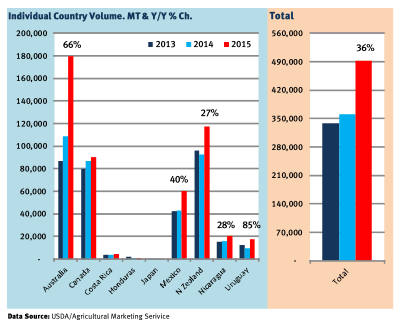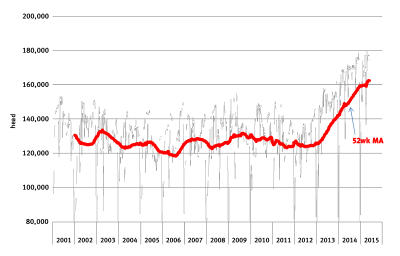Beef Imports Up
U.S. beef imports up 36% through May.
Tight U.S. domestic beef supplies (especially supplies of lean grinding beef), record U.S. cattle prices and a strong U.S. dollar have combined to increase the supply of beef imported into the United States. We would argue the United States is today the most lucrative market for grinding beef in the world. The surge in beef imports during the last 12 months is clear evidence of that.

While imports are a very small part of the supply/demand balance sheet for pork, chicken and turkey, they are significant for beef, accounting for roughly 12% of the available supply in 2014. We calculate this number by taking domestic production, subtracting exports and then adding the amount of imported beef. Last year, this supply was 24.6 billion pounds (lb.). Imports were 2.9 billion lb. (carcass weight basis).
The latest USDA World Agricultural Supply and Demand Estimates (WASDE) report forecast beef imports at 3.1 billion lb., 5.7% higher than a year ago. That forecast is much higher than earlier expected, and yet it may prove to be too low. Through the end of May, U.S. beef imports are up 36% compared to the same period a year ago. The chart above shows beef imports by country as reported by the USDA Agricultural Marketing Service (AMS).
In the past we have relied on data supplied from U.S. Customs, but we have found that recently their data are somewhat incomplete. Also, the data do not include product that has entered the country paying out-of-quota duties, something that may end up being a significant factor this year. Uruguay has an annual quota allocation of just 20,000 metric tons (mt). So far, imports from Uruguay are 17,868 mt and Uruguayan export data show they continue to ship around 2,000 mt a week to the United States and have shipped around 33,000 mt so far. By the end of the year, Uruguay will likely hit 60,000 mt, a large portion of that paying the 26.4% tariff. In-quota product pays 4.4¢ per kilogram (kg). It speaks volumes that countries are shipping product here even as 26.4% of the selling price goes to the government. Despite the increase, Uruguay is only a small part of the overall imported beef picture.

Australia remains, by far, the primary supplier of imported beef to the United States. According to the AMS data, beef imports from Australia through the end of May were 179,640 mt, 71,118 mt (+66%) higher than the same period last year. The Australian dollar has gone from trading near parity with the U.S. dollar to now trading at a significant discount. June futures currently peg the exchange at 0.76¢ U.S. per 1 Australian dollar (AUD).
Last year at this time the exchange was around 0.94¢ U.S. per 1 AUD. If the price of 90 chemical lean (CL) beef today were the same compared to a year ago (it is actually higher), the shift in the exchange rate alone would represent a 24% increase in value. In other words, Australian producers have received a 24% price increase from the currency change alone.
Last year the price of imported 90 CL beef in the United States [free on board (f.o.b.) U.S. East Coast] was $2.11 per lb., compared to $2.28 per lb. today — another 8% increase in value. For Australian packers, prices for imported beef currently are some 32% higher than they were a year ago in Australian dollar terms. It is little wonder they continue to aggressively bid on cattle down under.
The Australian Eastern Young Cattle Indicator currently is up some 50% compared to a year ago. Cattle slaughter in Australia has increased sharply in 2014 and 2015 (see chart). Last year, the high slaughter numbers were due to drought. Currently they are up due to much higher prices being paid. Weather remains a key driver for Australian beef supplies and a break in the drought could cause supply availability to tighten. Brazil may start shipping product to the United States. They are limited by quota but, as we saw with Uruguay, when the price is high enough the quota is not a factor.

Editor’s Note: The Daily Livestock Report is published by Steve Meyer & Len Steiner Inc. of Adel, Iowa, and Merrimack, N.H. To subscribe, support or unsubscribe visit www.dailylivestockreport.com. Articles in the EXTRA are reprinted with their permission.





